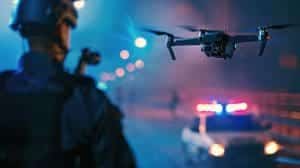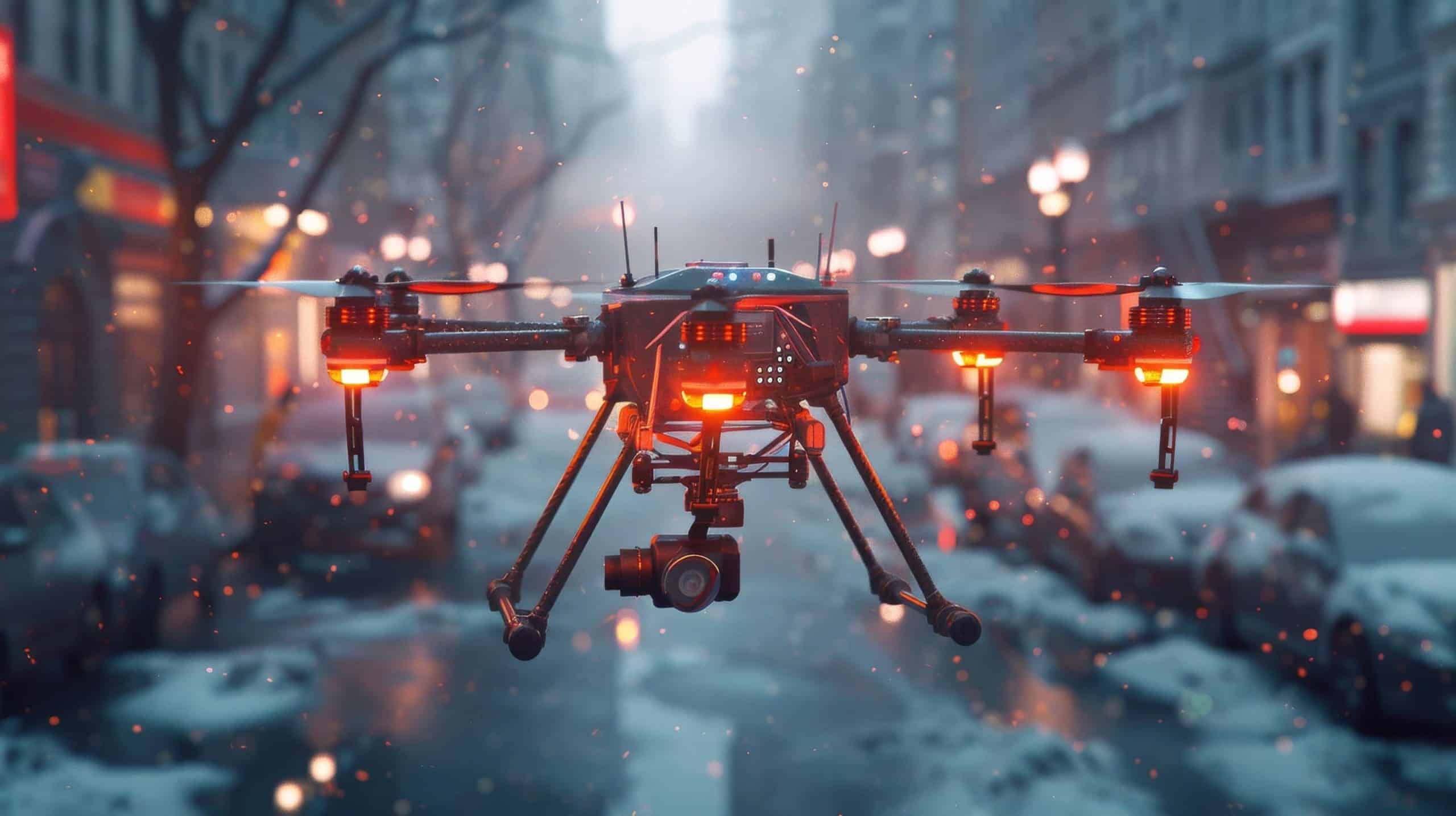Drones have rapidly evolved from niche gadgets to essential tools in public safety operations worldwide. As technology advances, public safety drones are increasingly integrated into various aspects of emergency response, law enforcement, disaster management, and more. In this blog, Maris-Tech, a leading edge computing company, will explore the historical context and evolution of drone use in public safety, as well as its advantages, notable applications, challenges, and future trends.
Historical Context and Evolution of Drones Used for Public Safety
The journey of drones in public safety began with their early applications in search and rescue missions. Initially, drones were primarily used for military purposes, but their potential for civilian use quickly became evident. In 2005, a public safety drone was employed to assist in locating a missing person in Ocila, Georgia. This marked one of the first significant uses of drones for public safety, demonstrating their ability to access challenging terrains and provide aerial views, greatly expediting search efforts.
As technology advanced, the applications of drones expanded beyond search and rescue. Fire departments began using firefighting drones to gain a better vantage point during their efforts, while law enforcement agencies employed them for surveillance, accident reconstruction, and crowd monitoring during public events. These early adopters paved the way for the widespread adoption of drones in public safety.
Advantages of Using a Drone for Public Safety
Drones offer numerous advantages that make them indispensable tools for public safety agencies. Below are some of the benefits of using a public safety drone.
Using Public Safety UAVs for Improved Response Times and Situational Awareness
One of the most significant advantages of UAVs is their ability to provide immediate access to aerial perspectives. Drones can cover large areas quickly, which is particularly valuable during search and rescue missions, disaster response, or monitoring large-scale events. Real-time data from drones enhances situational awareness, allowing public safety agencies to make informed decisions swiftly.
Cost-effectiveness and Resource Optimization
Drones are considerably more affordable to operate and maintain than traditional aircraft or ground-based surveillance systems. They require less personnel, have lower maintenance costs, and reduce the need for extensive infrastructure. By maximizing the utilization of drones, public safety agencies can allocate their financial resources more efficiently, allowing them to invest in additional equipment or training programs.
Minimizing Risks to Personnel with Public Safety Drones
Drones play a crucial role in minimizing risks to personnel in hazardous situations. In scenarios like search and rescue operations, disaster response, or situations involving armed suspects, sending public safety drones to assess the situation is far safer than exposing responders to potential danger. Drones can reach areas that are physically inaccessible or too dangerous for humans, such as disaster-stricken zones with unstable structures or hazardous materials.
Enhanced Data Collection and Analysis
Drones can be equipped with advanced cameras, thermal imaging, and other sensors that will enhance data collection and analysis. For example, drones with Maris Edge advanced video solutions can capture high-resolution imagery, video, and environmental data from various perspectives. This rich data can be used for evidence collection, documenting disaster damage, monitoring crowds, and environmental assessments. The ability to process and analyze this data in real time provides critical insights, allowing public safety agencies to adapt their strategies promptly.
How Can Drones Improve Public Safety? Notable International Applications
Drones have proven to be invaluable assets in various public safety scenarios across the globe. In addition to the wide range of general drone applications, here are some notable international applications where public safety drones have significantly enhanced emergency response and disaster management efforts:
- Hurricane Harvey (USA): During Hurricane Harvey, drones were extensively used to survey flood-affected areas in the United States. These public safety UAVs provided real-time imagery, helping emergency responders pinpoint individuals in need of rescue and assess the extent of the damage.
- Queensland Floods (Australia): Australia has witnessed the effective use of drones during natural disasters like the Queensland floods. Drones for search and rescue were instrumental in locating and assisting stranded individuals in inundated areas, showcasing their value in disaster response efforts.
- Finnish Archipelago (Finland): In Finland, drones are utilized for search and rescue operations in the archipelago. Their ability to access remote and rocky islands has proved vital in locating missing persons and providing timely assistance.

Pioneering Countries of Public Safety Drone Adoption
Several countries have emerged as pioneers in harnessing the potential of drone technology for public safety.
United States
With over 18,000 law enforcement agencies and almost 30,000 fire departments, the United States is a leader in integrating public safety drones. Agencies like the Federal Aviation Administration (FAA) have been instrumental in shaping the regulations and strategies for public safety drone usage.
United Kingdom
The United Kingdom is a frontrunner in integrating public safety drones into its operations. Multiple agencies, including the police, fire and rescue services, and search and rescue teams, employ drones in various roles. The regulatory authority governing drones in the UK is the Civil Aviation Authority (CAA).
Australia
Australia is renowned for its proficiency in utilizing drones for public safety. Agencies like the New South Wales Rural Fire Service, the Queensland Police Service, and the Australian Maritime Safety Authority have successfully integrated drones into their operations. The Civil Aviation Safety Authority (CASA) oversees drone operations and safety in Australia.
Finland
Finland has embraced public safety drones for a wide range of applications, including search and rescue missions, border surveillance, and disaster response. Agencies like the Finnish Border Guard and the Finnish Transport and Communications Agency have adopted drones, with regulations governed by Traficom.
Norway
Norway has taken a leading role in adopting drones into its public safety operations. Agencies such as the Norwegian Police Service and the Norwegian Directorate for Civil Protection utilize public safety UAVs for search and rescue missions and disaster response. The Civil Aviation Authority of Norway oversees drone regulation.
Challenges and Concerns for Drones in Public Safety Overseas
While drones offer numerous advantages, their integration into public safety operations comes with challenges and concerns.
Privacy and Legal Issues with Public Safety UAVs
Privacy concerns are at the forefront of the challenges surrounding the global use of public safety drones. While these devices enhance security and emergency response capabilities, they also have the potential to infringe on individuals’ rights to privacy. Legal frameworks are continuously evolving to address these concerns, but creating comprehensive and standardized regulations for drone use across borders remains a daunting task.
Cybersecurity Threats for a Public Safety Drone
Another area of concern is the cybersecurity threats associated with public safety drones. Drones rely on communication networks, GPS systems, and digital data storage, making them susceptible to cyberattacks. Ensuring the security of communication channels and data storage is vital, especially in situations where drones are involved in sensitive missions.
Regulatory and International Cooperation Roadblocks
The international nature of a public safety drone complicates the establishment of clear, consistent, and universally accepted regulatory frameworks. Each country has its own set of rules and regulations governing drone operations, leading to discrepancies in standards and expectations. Harmonizing regulations and promoting international cooperation are essential to facilitate the seamless operation of drones across borders.
Future Trends and Opportunities for Drones and Public Safety
The relentless pace of technology ensures that drones will become even more capable, versatile, and accessible in the years to come. Some of the imminent technological trends include:
- Artificial intelligence: Drones are using AI to enhance their autonomy and decision-making capabilities, enabling them to respond to dynamic situations more intelligently and effectively.
- Swarm technology: The concept of drone swarms, where multiple drones work collaboratively, is gaining ground. This technology can be a game-changer in search and rescue missions, disaster response, and surveillance operations.
- Extended flight times: Improvements in battery technology and energy-efficient designs will extend drone flight times, allowing for longer missions and wider coverage areas.
- Environmental adaptability: Future drones will be better equipped to operate in challenging environments, from extreme weather conditions to densely populated urban areas.
- Enhanced sensors: Advances in sensor technology will provide drones with even more comprehensive data collection capabilities, including improved environmental monitoring and threat detection.
Moreover, the global community is increasingly recognizing the value of international collaboration in harnessing the potential of public safety drones. Some key areas for expanding global partnerships include:
- International disaster response: Drones can play a pivotal role in coordinating international disaster response efforts. By sharing drone resources, countries can respond more swiftly and effectively to natural disasters.
- Cross-border security: Combating transnational threats, such as drug trafficking or terrorism, can benefit from international cooperation involving drones. Shared surveillance data and coordinated drone operations can bolster border security.
- Knowledge exchange and standardization: Countries can work together to exchange best practices, data, and experiences in drone operations. International standardization efforts can help harmonize drone regulations and procedures.
The Road Ahead for Public Safety Drones with Maris-Tech
The future potential of public safety drones is vast and exciting. Advances in technology and growing international cooperation are paving the way for public safety drones to become indispensable tools for emergency response and law enforcement agencies.
MARIS Technologies is at the forefront of this revolution, providing cutting-edge drone technologies and solutions designed to meet the evolving needs of law enforcement and public safety agencies. With a commitment to innovation and excellence, MARIS Technologies ensures that clients benefit from the latest advancements in drone technology, tailored to their specific requirements.
To learn more about advanced drone technologies and solutions for public safety, contact MARIS Technologies.
Explore Maris Tech’s tactical situational awareness system.


